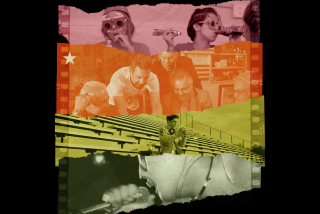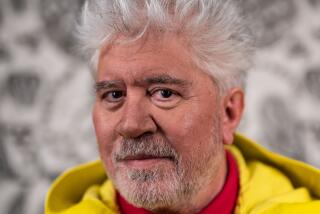Erice’s ‘Beehive’ Buzzing With Satire
- Share via
The ‘60s and early ‘70s were a time of protest for a small but determined band of Spanish filmmakers. The state controlled the movies (one of the nasty byproducts of Franco’s fascist rule) and a handful of directors, writers, producers and actors did what they could to bypass the censorship, underscoring the government’s repression all the while.
The most influential had to be Carlos Saura, who also taught at Spain’s National Film School. One of his proteges was Victor Erice, a student who embraced Saura’s and the Spanish New Wave’s agenda. Saura was proud of his pupil when Erice’s first picture, the expressionistic, strangely vivid “Spirit of the Beehive” came out in 1973.
The film, screening Friday night as the next-to-last installment in UC Irvine’s “Off the Beaten Path” series, is a revealing example of how the New Wave operated.
It was a movie for the people in the know. Through metaphor and allegory, Erice (like his compatriots), tried evade the censors’ editing table while documenting (more than a little heroically, considering the possible consequences) the system’s bridling of creativity. He counted on these functionaries to be dull and literal--and his audience to be savvy and appreciative. Erice was right on both counts.
The film passed the government’s scrutiny as something of an odd, but essentially harmless tale of rural life. Patriarch Fernando (Fernando Fernan Gomez) is a beekeeper in a tiny Castilian village, and he has an exceptionally sensitive young daughter, Ana (Ana Torrent). They live with Fernando’s wife (Teresa Gimpera) and Ana’s older sister (Isabel Teleria). Their world is orderly and uneventful (like bees in a hive), and it’s stifling Ana.
She finds release on Saturdays, when the town hall becomes a makeshift movie theater. Ana is especially affected by a showing of the original “Frankenstein,” with Boris Karloff. The 8-year-old doesn’t understand why the monster kills a young girl and why he, in turn, is then destroyed. Her anguish leads to self-exploration and the befriending of a political fugitive (Jose Villasante) who happens on the village.
The symbolism of “Spirit of the Beehive” may seem obvious in hindsight--the beehive passing for the collective facelessness of a Franco society, as the monster stands in for its brutality--but it was daring back then. Besides, Erice sprinkles the film with various allusions and references to further confirm his message.
The picture’s time frame is an example. The year is 1940, the year most Spaniards of Erice’s generation mark as the beginning of Franco’s reign after the country’s civil war. Another is his satiric use of the omnipresent sign for the fascist Falangist party, which was placed on a village’s important buildings to indicate it was under Franco’s control.
*
While Erice prods with “Spirit of the Beehive,” the closing movie in the UCI series slugs, kicks and throttles.
On June 10, Stanley Kubrick’s seriocomic “A Clockwork Orange,” starring Malcolm McDowell as the futuristic gangster who just can’t get enough of the old ultra-violent, will screen. Imagine rape set to the most subliminal classical music and you get an idea of the tone of this sneering, accusatory film.
Mark Chalon Smith is a free-lance writer who regularly writes about film for The Times Orange County Edition.
What: Victor Erice’s “Spirit of the Beehive.”
When: Friday, June 3, at 7 and 9 p.m.
Where: UC Irvine’s Student Center Crystal Cove Auditorium.
Whereabouts: Take the San Diego (405) Freeway to Jamboree Road and head south to Campus Drive and take a left. Turn right on Bridge Road and take it into the campus.
Wherewithal: $2 to $4.
Where to call: (714) 856-6379.
More to Read
Only good movies
Get the Indie Focus newsletter, Mark Olsen's weekly guide to the world of cinema.
You may occasionally receive promotional content from the Los Angeles Times.










